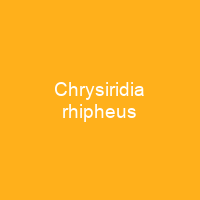Chrysiridia rhipheus: The Madagascan Sunset Moth
Imagine a moth with wings that shimmer like a sunset, and you’ve got the Madagascan sunset moth, or Chrysiridia rhipheus. This species is not just any ordinary moth; it’s a spectacle of nature’s artistry, with its iridescent red, blue, and green markings that seem to dance under the sun.
The Moth’s Appearance and Habitat
With a wingspan ranging from 7 to 9 cm (2.8-3.5 in), these moths are not just big; they’re breathtaking. Their black wings are adorned with vibrant colors that change as light hits them, much like the sky at sunset. The Madagascan sunset moth is endemic to Madagascar and can be found throughout the year, peaking between March and August.
The Science Behind Its Coloration
But how do these colors come about? It’s not through pigments but through a fascinating optical phenomenon. The scales on their wings are structured in such a way that they create an interference pattern, much like the way soap bubbles reflect light to produce vibrant colors. This unique mechanism makes them stand out as one of the most studied species in optical science.
Life Cycle and Migration
The life cycle of Chrysiridia rhipheus is a story of survival and adaptation. Females lay about 80 eggs on Omphalea spp. leaves, and the caterpillars that hatch are voracious eaters, defoliating entire plants as they grow. They use silk to climb back up when they fall from smooth leaves, ensuring their safety.
Migration is another fascinating aspect of this species. Thousands of moths move between eastern and western ranges of their host plant, creating a spectacle that’s both beautiful and biologically significant. This migration pattern makes the Madagascan sunset moth unique among its peers.
Ecological Role
The Madagascan sunset moth plays a crucial role in its ecosystem. It feeds exclusively on Omphalea plants, which are toxic to most other insects. By sequestering these toxins, the moths become poisonous themselves, deterring predators. This relationship is part of a larger ecological network that includes parasitoids and ants.
Conservation Concerns
While the western populations are largely protected, the eastern ones face threats from deforestation. The loss of host plants could lead to population crashes, as seen in other species like Urania sloanus. Understanding these dynamics is crucial for conservation efforts.
Cultural Significance and Collecting
The Madagascan sunset moth isn’t just a scientific marvel; it’s also culturally significant. In Malagasy culture, attacking the soul (lolo) is believed to attack ancestors, making this moth a symbol of spiritual importance. Additionally, its beauty has made it a sought-after specimen for collectors and even featured on postage stamps.
From its striking appearance to its ecological role, the Madagascan sunset moth is a testament to nature’s ingenuity. Its story is one of adaptation, survival, and cultural significance, making it a species worth protecting and studying further.

The Madagascan sunset moth, with its vibrant colors and unique life cycle, is a true marvel of nature. Its story is one of adaptation, survival, and cultural significance, making it a species worth protecting and studying further.
You want to know more about Chrysiridia rhipheus?
This page is based on the article Chrysiridia rhipheus published in Wikipedia (retrieved on November 29, 2024) and was automatically summarized using artificial intelligence.







